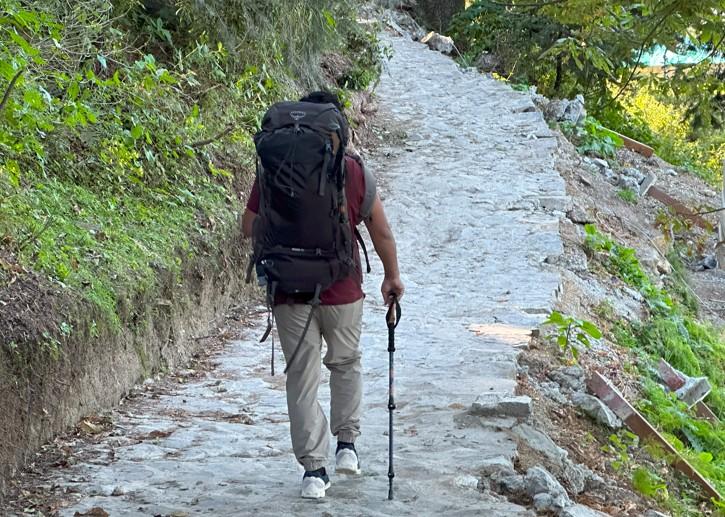A good pack fits right, distributes weight well, and keeps your essentials accessible and protected. After more than 15 years of carrying packs in the backcountry, I’ve come to appreciate just how important your backpack really is.
Aside from your boots, it’s the single most important piece of gear you’ll carry. If you get it right—it’ll carry your gear comfortably and reliably. And what about the wrong one? It’ll rub you raw, throw off your balance, and leave you counting the miles back to the trailhead.
Related: How to Choose a Daypack for Hiking
Choosing the right backpack isn’t just about size or brand—it’s about finding something that fits your body, suits your style of hiking, and works with the kind of gear you carry. And if one pack is popular among backpackers, that does not mean it will fulfill your backpacking needs
This guide is aimed at beginners through to intermediate hikers who are either buying their first pack or looking to upgrade to something better suited to their needs.
Finding the Right Backpacking Backpack: Field-Tested
Start with Your Backpacking Style
Before choosing a backpack, it’s worth taking a step back and thinking about your backpacking style. You should ask yourself the following questions:
- What sort of trips are you planning?
- Is it a quick overnight trip?
- Multi-day adventures?
- Longer thru-hikes?
And then think about the environment where you are typically going to backpack. It can be:
- Alpine conditions
- Dry desert heat
- Humid forests
- Rainy weather
Each scenario affects what kind of pack you’ll need in terms of volume, features, and carrying capacity.
An overnight hike in mild conditions requires a very different pack than a multi-week trek through alpine terrain.
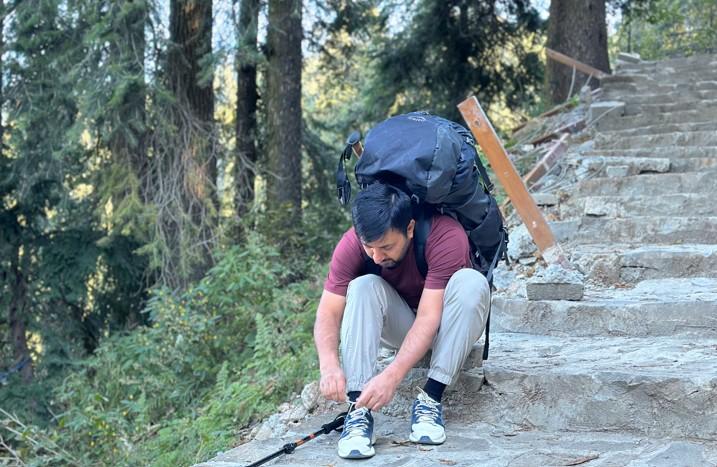
Trip length is a good place to start. A short overnight hike won’t require as much capacity, whereas a thru-hike or extended backcountry trip means carrying more gear, food, and potentially a heavier load.
Then there’s the type of gear you’re carrying. If you’ve gone down the ultralight path, you’ll get away with a much smaller, frameless pack. Others enjoy a more relaxed pace and a bit of extra comfort. In that case, it’s worth choosing a slightly larger pack with good load-carrying support and external storage to accommodate the extras that make camp life a bit more enjoyable.
Matching your backpack to how and where you hike is the first and most important step in choosing the right one.
Capacity: How Much Capacity Do You Really Need?
From what I’ve observed, a 65-litre pack is the most common size out there. It strikes a balance between space and practicality for most multi-day trips. Still, capacity is personal.
If you’re new to hiking, see if you can borrow or rent a pack and test it on a weekend hike. That way, you’ll get a feel for how much space you really need before making the investment.
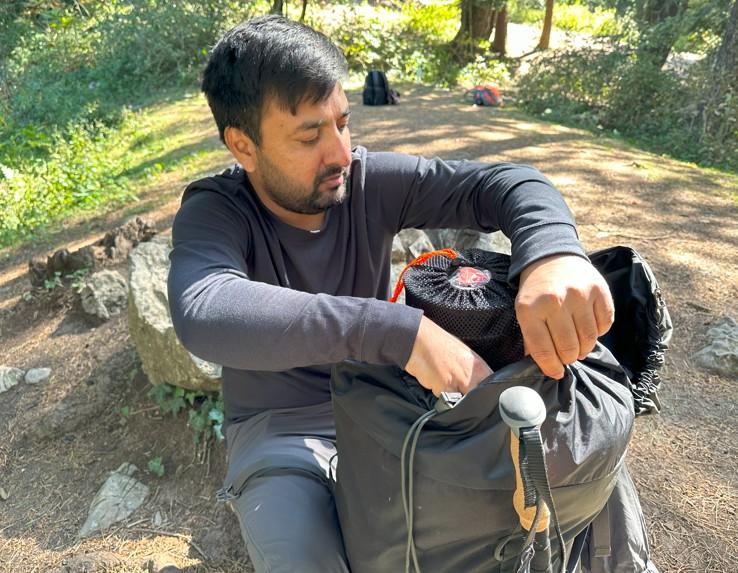
When it comes to backpack capacity, more isn’t always better, as new backpackers might think. It’s easy to assume that a bigger pack will be more versatile, but in practice, that often just means more space to fill—and more weight to carry.
As a general guide:
- 30–50L: Overnight or ultralight trips
- 50–70L: Weekend to 4-day trips (most popular)
- 70L+: Extended or gear-intensive trips
One thing I’ve seen time and again—especially with new hikers—is falling into what I call the empty space trap. You buy a 75L pack “just in case,” and suddenly, every bit of that space is filled with gear you may not need.
A smaller pack forces you to be more disciplined in your packing, and in the long run, that usually means a lighter, more comfortable hike.
Fit: What We’ve Learned About Backpack Fit
Fit is the single most important feature of any backpack—and ironically, it’s the one thing most people overlook. You can nail the size, features, and style of your backpack—but if it doesn’t fit your body, none of that will matter.
The key is to focus on torso length, not your height. You’ll often hear people say they’re a medium or a large based on their height, but that’s not accurate when it comes to packs. It’s your torso length—from the base of your neck (C7 vertebra) to the top of your hipbones—that determines the correct size.
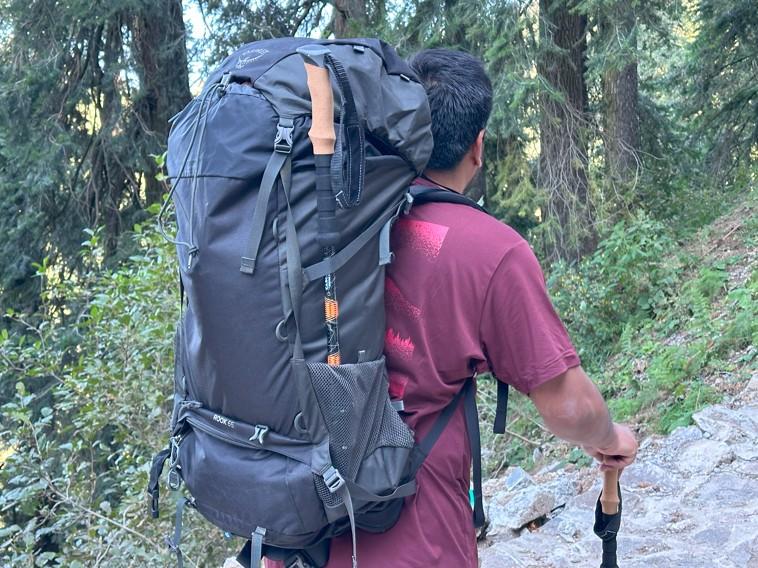
Equally important is the hip belt fit. This is where the majority of your pack’s weight should sit—not on your shoulders. A properly fitted hip belt will wrap around the top of your hips (the iliac crest) and take the bulk of the load. If the belt’s too high or too low, you’ll end up with sore shoulders or hip bruising by the end of the day.
Do you know why I like modern backpacks? You can adjust them, as they allow you to tweak the harness system, shoulder straps, hip belt, and load lifters.
You want the shoulder strap attachment points to sit just below the top of your shoulders—about 2 cm or so. This lets the load lifters do their job, pulling the pack closer to your body and keeping the weight centered.
Frame Type: Internal, External, or Frameless
Backpack frame type is one of those behind-the-scenes features that has a big impact on how a pack carries—and how your body feels after a long day on the trail.
Most modern backpacking packs fall into three categories:
- Internal frame
- External frame
- Frameless
Internal Frame
This is what most modern hikers use. Internal frames are built into the pack’s body and provide just enough rigidity to keep your gear stable and close to your back.
They’re ideal for most situations—whether you’re doing an overnighter or tackling a multi-day trek. The close-fitting design also helps with balance, especially on uneven terrain.
External Frame
These are becoming rare and tend to suit specific needs. You’ll sometimes see them used by hunters or hikers carrying awkward or heavy loads.
External frames are great for load-hauling and ventilation. That said, they tend to be heavier, noisier, and less agile on technical terrain.
Frameless
Frameless packs strip things back to the basics. They’re lightweight and minimalist—perfect for day hikes or for those who’ve refined their gear list down to a science.
I once went frameless on a summer Sierra trip and quickly learned that while the weight savings were great, the comfort trade-off wasn’t worth it on longer hauls. Without structure, even 8–10 kg can start to feel pretty unwieldy.
The majority of packs today come with some form of internal frame, and for good reason—they strike the right balance between structure, comfort, and versatility. Frameless packs are best suited to experienced ultralight hikers, while external frames are now more of a specialist tool.
Suspension System
A well-designed suspension system can make the difference between a comfortable hike and one that leaves you counting every painful step. It’s the engine room of your backpack—the part that determines how well the load rides and how your body feels at the end of the day.
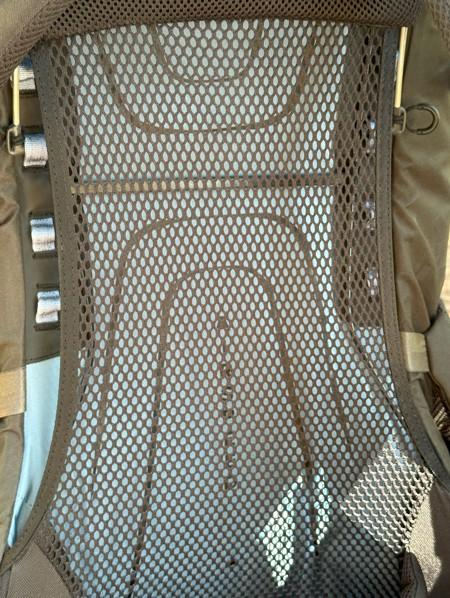
I’ve found that great suspension is what separates a dependable workhorse from a gear closet relic. If the pack doesn’t sit well with weight, it’s a no-go—even if it ticks every other box.
I always check for hip belt padding, frame stiffness, and whether the pack shifts around when loaded. A poor suspension system can turn a 10 km walk into a real slog, so test before you buy if you can.
What makes a good suspension system:
- Sturdy frame sheet
- Quality hip belt padding
- Ventilation (trampoline or standard)
I once hiked 16 kilometres into the backcountry with a pack that had minimal hip padding. By kilometre ten, I was shifting and adjusting every few minutes—not exactly the immersive wilderness experience I’d planned.
Prioritise suspension systems with supportive frames, cushy yet firm hip belts, and good airflow if you’re doing long hauls or hiking in hot weather. Most modern packs use either foam padding or a trampoline-style mesh to support your back.
Key Features That Matter (and Which Are Just Marketing)
Backpack features can be a mixed bag. Some deliver real-world trail value, while others look good on paper but never get used. With experience, I’ve learned to separate the genuinely helpful features from those that just add weight or complication. If you’re shopping for your next pack, here’s what matters—and what doesn’t.
Essential:
- Hip belt pockets
- Hydration reservoir compatibility
- External storage (stretch pockets, daisy chains)
- Sleeping bag compartment
Nice-to-have:
- Adjustable top lid
- Side zip access
Skip it:
- Built-in rain covers (often subpar)
- Overly complex strap systems
I once used a pack that had more straps than I knew what to do with. It looked fancy, but in practice, I was constantly adjusting, clipping, or untangling something.
On another trip, having quick access to hip belt pockets and stretch side pockets made all the difference. It’s not about how many features you have—it’s about how well they work in real conditions.
Weight
Weight is one of the first things people ask about when comparing packs. It’s tempting to aim for the lightest option on the shelf, especially if you’re trying to shave grams from your gear list. But over the years, I’ve found that chasing ultralight numbers can sometimes come at a cost—usually to your comfort or durability.
Here’s how most packs break down:
- Ultralight (Under 2 lbs / ~900 g): Minimalist builds, little to no frame support, and stripped-down features. Ideal for experienced ultralight backpackers with dialled-in gear systems.
- Midweight (2.5–4 lbs / ~1.1–1.8 kg): The sweet spot for most backpackers. Balanced support, decent durability, and enough comfort for multi-day trips.
- Heavyweight (Over 5 lbs / ~2.2 kg): Rugged packs built for heavy loads and long-haul treks. Excellent suspension systems, but the weight penalty can add up.
It’s all about the trade-offs. A pack that’s too light might wear out sooner or become uncomfortable with a moderate load. A pack that’s too heavy can wear you out just as fast. Aim for something that’s durable enough for the conditions you’ll face, but not so overbuilt that it becomes a burden.

If you’re new to backpacking, aim for a pack in the 1.5–2.2 kg range. It’ll give you solid support without excessive weight. And don’t be fooled by ultralight marketing—the best pack is the one you can wear comfortably all day, every day.
Durability & Materials
When it comes to backpacking gear, durability is often what separates a season-long investment from a pack that can last a decade. Modern packs use a range of materials designed to balance weight, durability, and weather resistance:
- Robic Nylon – A popular choice for its good balance of strength and weight.
- Cordura – Heavier but incredibly durable, ideal for rough conditions.
- Dyneema (formerly Cuben Fiber) – Extremely light and strong, though it comes at a premium price.
Each fabric has its place. If you’re mostly on groomed trails, Robic will likely do just fine. For alpine routes or thick scrub, Cordura can take more of a beating. Dyneema is well-suited to ultralight setups and wet conditions due to its waterproof properties.
What to Inspect
Durability isn’t just about fabric—it’s also in the build quality:
- Double or bar-tack stitching at load points
- Burly YKK zippers that don’t snag or slip
- Reinforced base panels and shoulder strap junctions
- Solid attachment points for trekking poles or ice axes
Beyond fabric, check the stitching, especially around load-bearing points like shoulder straps and hip belts. Zippers should run smoothly and feel robust—snaggy or flimsy zippers don’t get better with time. Reinforced stress points can go a long way toward extending the lifespan of your pack.
Women’s-Specific and Youth Packs
When it comes to choosing a backpack, one size doesn’t fit all—literally. Women and younger hikers often have different body shapes and proportions, which can make all the difference in how a pack carries over long distances.
Women’s packs feature:
- Shorter torso lengths for a more accurate fit
- Angled shoulder straps that contour around the chest
- Sculpted hip belts that sit comfortably on the hips without digging in
Youth Packs: Growing Room Included
Youth-specific backpacks prioritize adjustability:
- Sliding torso systems for height changes
- Adjustable hip belts for developing hips
- Simple harnesses that are easy to fit as teens grow
Don’t buy “big to grow into.” A poorly fitted pack—especially on a developing frame—can lead to soreness and bad habits on the trail. Choose a pack that fits now but has room to adjust over the next few seasons.
Final Thoughts: Buy It for Fit, Not Just Features
At the end of the day, the best pack is the one you barely notice. It shouldn’t shift uncomfortably, dig into your shoulders, or make your back ache halfway through the day. If you forget your pack is even there, you’ve chosen the right one.
Don’t get distracted by the latest gimmicks or marketing buzzwords. Instead, focus on how a pack fits your body, how it suits your style of hiking, and whether it carries your gear the way you need it to. Comfort, function, and fit should always trump flashy extras or big-name branding.
A well-chosen pack becomes part of your rhythm on the trail. When it works right, it fades into the background—and that’s exactly where it should be. Over 15 years of backpacking, the packs that lasted weren’t the lightest or the fanciest—they were the ones that fit right and handled my gear without fuss.
If you’re looking for a real-world example of a beginner-friendly, budget-conscious pack, check out my hands-on Osprey Rook 65 Backpack review.
